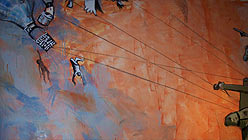As I sat on the chair in Galeria de la Raza Saturday afternoon, a young man with an American flag scarf wrapped around his leg sat down on the floor beside me.
His questions were short, half in Spanish, half in English. “Where did you?” “Shoes?” He pointed to my sandals. Could he? He touched my sandals’ soft worn straps and took off his sneakers, so hot around his bare feet. Okay, I said, he could try one on. I gave him one of my shoes and he slid his foot into it. Then we sat together, each of us with one bare foot, saying words the other one didn’t understand, smiling to soften our miscomprehension.
I was at the gallery to see On the Wall, an exhibit featuring a large mural and video. The works, created by the Trust Your Struggle artist collective and artists from the Kearny Street Workshop, examine “the current issues of the immigration debate, such as shifting identities, cultural ownership and community building,” according to the gallery’s Web site.
The mural, which covers every inch of the gallery’s walls, was created by four artists from the Trust Your Struggle collective over a weeklong period. When the show ends September 26, 2008 it will disappear. It is unique and ephemeral; its residence temporary. The mural’s eventual demise is an obvious metaphor for migration and its attendant disruptions. We lose things when we move, it reminds us. We often do not get them back.
The mural itself consists of several scenes, some more intelligible than others. Some walls are a collage of figures and patterns, stenciled words and patches of color. A woman with long braids and a purple face bends over as though performing manual labor. Behind are painted strips of lace, mimicking the tiers of a dress. “They can’t deport us,” it reads in thick black type. Sprays of purple and red paint spread around the words. “1848” is written further up the wall, referencing the end of the U.S.-Mexico War, and the United States’s acquisition of what is now California.


